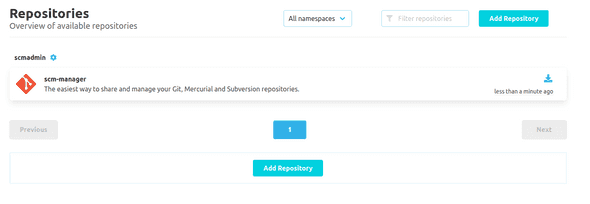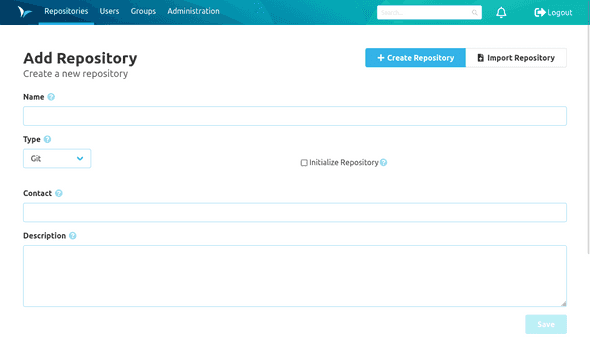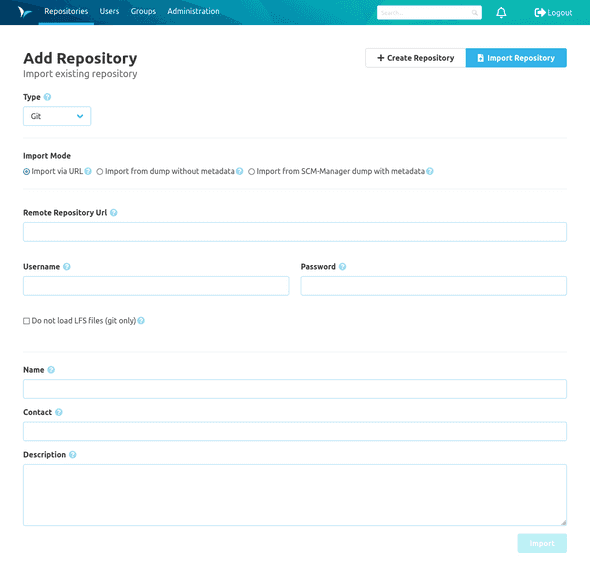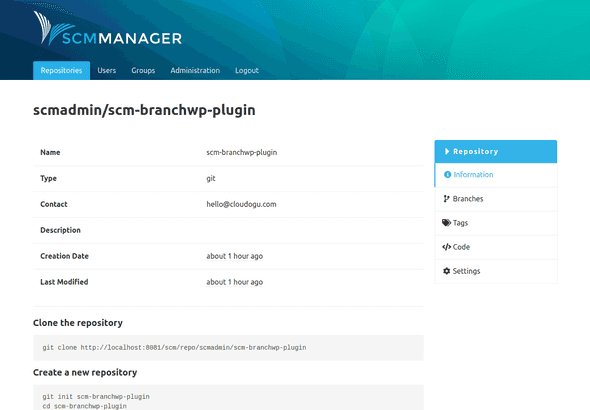Repository
The Repository area includes everything based on repositories in namespaces. This includes all operations on branches, the code and settings.
Overview
The repository overview screen shows all repositories sorted by namespaces.

Using the select box at the top of the page you can restrict the repositories shown for one namespace. Alternatively you can click on one namespace heading to show only repositories of this namespace. The search bar aside the select box can be used to arbitrarily filter the repositories by namespace, name and description.
Clicking the icon on the right-hand side of each namespace caption, you can change additional settings for this namespace.
Create a Repository
In SCM-Manager new Git, Mercurial & Subversion (SVN) repositories can be created via a form that can be accessed via the "Create Repository" button. A valid name and the repository type are mandatory.
Optionally, repositories can be initialized during the creation. That creates a standard branch (master or default) for Git and Mercurial repositories.
Additionally, it performs a commit that creates a README.md. For Subversion repositories the README.md will be created in a directory named trunk.
If the namespace strategy is set to custom, the namespace field is also mandatory. The namespace must heed the same restrictions as the name. Additionally, namespaces that only consist of three digits, or the words "create" and "import" are not valid. After typing the first characters, existing matching namespaces are suggested which can be chosen. To create a new namespace, this has to be chosen from the drop down explicitly.

Import a Repository
Besided creating new repositories you also may import existing repositories to SCM-Manager. Just use the Switcher on top right to navigate to the import page and fill the import wizard with the required information.
Depending on the type of the new repository, there are different "ways" to import repositories:
- Import via URL (Git and Mercurial only): Here the repository is imported from a remote server specified by the remote repository's URL. In addition, a username and a password can be provided. Furthermore, for Git repositories LFS files can be excluded (if LFS is used in the remote repository).
- Import from dump without metadata: Here a file can be uploaded. This may be a simple export from another SCN-Manager
instance, or a dump file from another repository:
- For Git and Mercurial, this has to be a tar packed file of the "internal" repository (the
.gitor the.hgdirectory). - For SVN a standard dump file created with
svnadmincan be used.
- For Git and Mercurial, this has to be a tar packed file of the "internal" repository (the
- Import from SCM-Manager dump with metadata: This option is to be used with exports of repositories with metadata from other SCM-Manager instances. It will be checked for data compatibility before import (the SCM-Manager and all its installed plugins have to have at least the versions of the system the export has been created on).
File dumps can be encrypted if they were exported from an SCM-Manager. In this case, the password has to be specified. If no password is set, the SCM Manager assumes that the file is unencrypted.
Your repository will be added to SCM-Manager and all repository data including all branches and tags will be imported.

Repository Information
The information screen of repositories shows meta data about the repository. Amongst that are descriptions for the different options on how the repository can be used. In the heading you can click the namespace to get the list of all repositories for this namespace.
